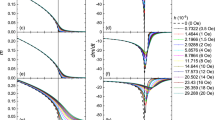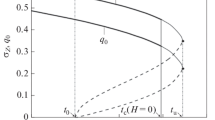Abstract:
For the ferromagnets EuS and GdMg, in which fourth-order exchange interactions (i.e. biquadratic, three-spin and four-spin interactions) have been identified, the deviation of the spontaneous magnetization with respect to the T =0 value is shown to follow a T2 law instead of the famous T3/2 law expected for a Heisenberg ferromagnet. Moreover, the observed T2 law holds for temperatures as large as 0.8TC and the extrapolated magnetization value for does not conform to ferromagnetic saturation. This is because the fourth-order exchange interactions generate a second order-parameter which is assumed to govern the order of the transverse moment components. These moment components have a finite expectation value for at the expense of the Heisenberg order parameter. Like the spontaneous magnetization, the critical field curves B c ( T ) of the metamagnet EuSe and the antiferromagnet EuTe also start decreasing with a T2 term for . It is argued that the T2 law is a consequence of the fourth-order exchange interactions. This is shown experimentally by a study of the critical field curves [0pt] pertinent to the longitudinal (Heisenberg) order-parameter in the diamagnetically diluted antiferromagnets EuxSr1-xTe. In this solid solution series a particular composition of x c =0.85 exists at which the different fourth-order interaction processes compensate each other in the high temperature average. As a consequence, an EuxSr1-xTe sample with x =0.85 meets the requirements of a Heisenberg antiferromagnet at least if a quantity is considered for which the high-temperature average over all fourth-order interactions is decisive. This seems to be the case for the critical field curve [0pt] which gives the phase boundary to the paramagnetic phase. In fact, a crossover from a T2 to a T3/2 law is observed for [0pt] on approaching xc. This, we believe, shows the frequently observed T2 law is caused by the fourth-order interactions.
Similar content being viewed by others
Author information
Authors and Affiliations
Additional information
Received 23 July 1998 and Received in final form 12 October 1998
Rights and permissions
About this article
Cite this article
Mueller, R., Köbler, U. & Fischer, K. On the T Bloch law in magnets with fourth-order exchange interaction. Eur. Phys. J. B 8, 207–216 (1999). https://doi.org/10.1007/s100510050683
Issue Date:
DOI: https://doi.org/10.1007/s100510050683




